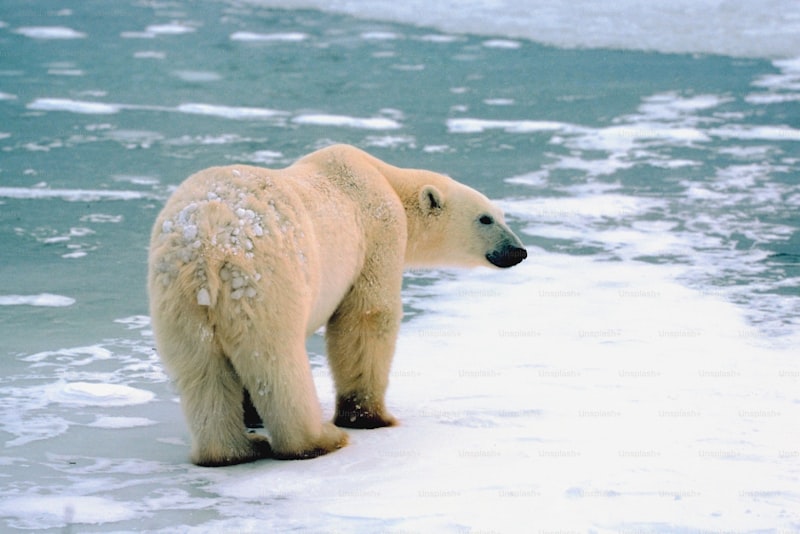Moreover, the melting ice alters their breeding and reproductive patterns. Female polar bears need stable ice to create dens for birthing and nursing their cubs. With melting ice, the availability of suitable denning sites decreases, leading to lower cub survival rates. This disruption in their reproductive cycle could potentially lead to declining polar bear populations over time.
Beyond habitat loss, climate change affects polar bears in less visible but equally critical ways. For instance, changes in ice cover can alter the distribution and availability of prey species, further complicating their ability to find food. This ecological imbalance can have cascading effects throughout the Arctic marine ecosystem, impacting other species as well.
The plight of polar bears serves as a poignant reminder of the broader consequences of climate change. Their struggle highlights the interconnectedness of ecosystems and the urgent need for global action to mitigate greenhouse gas emissions. By addressing the root causes of climate change, we can strive to preserve not only polar bears but also the delicate balance of our planet’s biodiversity.
Understanding these impacts underscores the importance of proactive conservation efforts and policies that prioritize sustainability. As we confront the challenges posed by climate change, safeguarding the Arctic and its iconic inhabitants remains a critical priority for environmental stewardship and future generations.
Arctic Alarm: Polar Bears Face Shrinking Ice and Uncertain Future
Imagine standing on the edge of a vast frozen sea, stretching endlessly towards the horizon. This is the realm of the polar bear, a creature uniquely adapted to thrive in one of the harshest environments on Earth. But now, this frozen expanse is diminishing. Climate change is causing Arctic ice to melt faster than ever before, leaving polar bears with less and less of their natural habitat to roam and hunt.
Why does this matter? Polar bears rely on sea ice as a platform for hunting seals, their primary food source. As the ice retreats, bears are forced to travel greater distances, expending more energy in search of food. It’s like having your supermarket shrink overnight, with no guarantee of finding groceries elsewhere. This struggle for survival is pushing polar bears to their limits, affecting everything from their reproductive success to their overall health.

Beyond the immediate challenges of finding food, shrinking ice also exposes polar bears to new threats. They face increased encounters with humans, more hazardous swimming conditions, and a precarious future for their cubs. It’s a complex web of challenges that threatens not just polar bears, but the entire Arctic ecosystem they call home.
The future remains uncertain for these Arctic giants. Conservation efforts are crucial, focusing on mitigating climate change and protecting critical habitats. Every action counts—from reducing carbon emissions to advocating for sustainable practices. By addressing the root causes of Arctic ice loss, we can give polar bears a fighting chance at survival in their icy realm.
Survival Struggle: How Climate Change Threatens Polar Bear Populations
These magnificent creatures, perfectly adapted to survive in the harshest conditions on Earth, now face unprecedented challenges. The melting of Arctic sea ice, their primary hunting ground, forces polar bears to travel greater distances in search of food. With thinner ice and longer swimming distances, many bears struggle to find enough seals, their main prey, leading to malnutrition and reduced survival rates.
Moreover, the changing climate disrupts the delicate balance of Arctic ecosystems. Polar bears depend on sea ice not only for hunting but also for breeding and raising their young. As ice retreats earlier in the spring and forms later in the fall, polar bear maternity dens are increasingly threatened. Cubs, born helpless and dependent, face a perilous start to life without stable ice platforms.
The implications of dwindling polar bear populations extend beyond their species. These iconic animals serve as indicators of the health of the entire Arctic ecosystem. Their decline signals broader ecological imbalances, affecting other wildlife and indigenous communities reliant on Arctic resources.
Efforts to mitigate climate change and protect polar bears are crucial. Conservation initiatives focus on reducing greenhouse gas emissions, preserving critical habitat areas, and promoting sustainable practices. Awareness and advocacy play pivotal roles in rallying global support for these vulnerable Arctic ambassadors.
As we confront the reality of climate change, the survival struggle of polar bears serves as a poignant reminder of the urgent need for action. Their fate hinges on our collective resolve to address environmental challenges and safeguard the Arctic wilderness for generations to come.
Melting Habitat: Polar Bears Forced to Adapt as Ice Disappears
Imagine a world where the vast ice sheets and floes, once stable platforms for hunting seals and raising cubs, are now fragile and unpredictable. This shifting environment forces polar bears to adapt like never before. Their traditional hunting grounds are diminishing, pushing them to travel longer distances in search of food. With less sea ice, these apex predators must swim greater distances, exhausting precious energy reserves just to find sustenance.
This changing landscape not only affects polar bear behavior but also threatens their very existence. As their primary habitat disappears, polar bears face increased competition for resources and encounters with humans as they venture closer to populated areas in search of food. Conservation efforts struggle to keep pace with these rapid environmental changes, striving to protect these iconic animals from the brink of extinction.
The plight of polar bears serves as a stark reminder of the urgent need for global action on climate change. Their struggle highlights the interconnectedness of ecosystems and the profound impact of human activity on the natural world. Each melting ice cap and diminishing polar bear population underscores the irreversible consequences of our carbon footprint.

As we witness the adaptation of polar bears to a rapidly transforming environment, we are compelled to consider our role in their survival. Can we mitigate climate change quickly enough to secure a future where polar bears roam their icy kingdoms freely? Or will we continue to witness their struggle to adapt as the ice continues to disappear?
Polar Bears on Thin Ice: Climate Change’s Toll on Arctic Predators
The Arctic, a region of extremes, is warming at an alarming rate, leading to the rapid disappearance of sea ice, crucial for the polar bear’s hunting and breeding cycles. As temperatures rise, the once solid ice sheets are melting, forcing polar bears to travel longer distances to find food. Their primary prey, seals, depend on sea ice to breed and give birth. With less sea ice, seals are harder to find, pushing polar bears to the brink of starvation.
Imagine a polar bear traversing miles of open water, its massive paws struggling to swim across vast expanses of ocean where ice once provided a solid platform for hunting. This new reality is not just a challenge but a crisis for these Arctic predators.
Climate change isn’t just affecting polar bears’ physical environment; it’s altering their behaviors too. Desperate for food, polar bears have been observed venturing into human settlements in search of alternative sources of sustenance. This behavior, once rare, is becoming more frequent as traditional hunting grounds vanish.
Moreover, the loss of sea ice threatens the very survival of polar bear populations. Scientists warn that if current warming trends continue unchecked, polar bears could face extinction in the wild within the next century. This sobering prospect underscores the urgent need for global action to combat climate change and protect the Arctic ecosystem.
Changing Tides: Climate Shifts Leave Polar Bears Hungry and Homeless
Imagine a world where the very ground beneath your feet seems to melt away, where the once solid ice floes are disappearing faster than snow in spring. This is the harsh reality for polar bears today. As temperatures rise and ice melts at alarming rates, their icy hunting grounds are shrinking. With fewer platforms from which to hunt seals, their primary prey, polar bears are finding it increasingly difficult to secure the nourishment they need to sustain themselves and their young.
The consequences of this ecological imbalance are stark. Hungry and desperate, polar bears are being forced to travel longer distances in search of food, often expending more energy than they can afford. This not only threatens their own survival but also disrupts the delicate balance of Arctic ecosystems. Without enough food, polar bear populations are declining, putting the future of these iconic animals in jeopardy.
Furthermore, the loss of their icy habitats has another devastating impact: it leaves polar bears homeless. These creatures are uniquely adapted to life on the ice, relying on its stability for denning and raising their cubs. Without suitable ice, they are forced to seek refuge on land, where resources are scarce and competition with humans and other wildlife is fierce.
In the face of such challenges, conservation efforts are more critical than ever. Scientists, governments, and environmental organizations are working tirelessly to understand the impacts of climate change on polar bears and to develop strategies to protect them. From tracking movements with satellite technology to advocating for international policies that reduce greenhouse gas emissions, every effort counts in safeguarding the future of these magnificent creatures.
As we witness the changing tides of our planet’s climate, the plight of the polar bear serves as a poignant reminder of the interconnectedness of all life on Earth. Their struggle is a call to action for each of us to take responsibility for our environmental footprint and to strive for a future where polar bears and other species can thrive in harmony with nature.
Frequently Asked Questions
What are the main threats climate change poses to polar bears?
Learn about the primary threats climate change poses to polar bears, including habitat loss due to melting sea ice, reduced access to prey species like seals, and increased competition from other predators. Understand how these factors impact polar bear populations and their long-term survival.
How are polar bears adapting to changing Arctic conditions?
Learn how polar bears are adapting to the changing Arctic environment with insights into their behavioral shifts and physiological adjustments.
What are scientists doing to study and protect polar bears from climate change?
Scientists are actively researching and implementing measures to study and safeguard polar bears from the impacts of climate change. This includes monitoring their populations, habitat conditions, and food sources, as well as advocating for policies that mitigate climate change effects. Conservation efforts also focus on creating protected areas and raising awareness to ensure the long-term survival of polar bears in their rapidly changing environment.
How does melting sea ice affect polar bear populations?
The melting of sea ice significantly impacts polar bear populations by reducing their hunting grounds and access to prey. As ice melts earlier and freezes later, bears face longer fasting periods, affecting their health and reproduction rates.
What can individuals do to help mitigate climate change and protect polar bears?
Learn how individuals can mitigate climate change and protect polar bears through actions like reducing carbon footprint, supporting renewable energy, advocating for conservation policies, and raising awareness.


